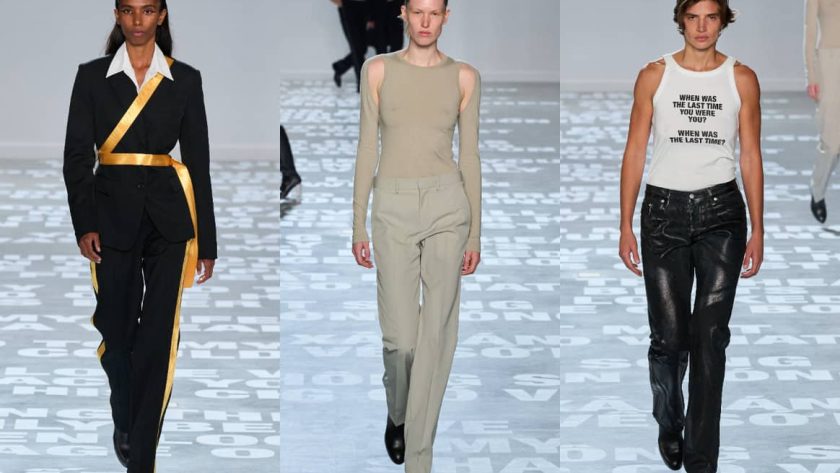New York City’s week-long, hazy heat wave did not stop the movers and shakers of New York Fashion Week as established houses and emerging designers alike presented their Spring/Summer 2024 collections.
In a time where luxury giants are dominating the industry, a very select few heritage houses (if any) showed in New York, as this season’s calendar was stacked with bright-eyed, independent designers.
After years sitting on the board, American designer Thom Browne – who notably was missing from the New York runway this season – was elected the CFDA’s chairman last November, promising the ushering of new talent and “nurturing the next generation of American design” as said in the official CFDA statement. The next generation is here now.
A task of both upcoming and preceding generations within the fashion world is social responsibility, a highly contentious topic in the industry. At the start of New York Fashion Week, Mara Hoffman and Remake took to the designer’s Soho store to celebrate the Fabric—or “Fashioning Accountability and Building Real Institutional Change”—Act, a federal bill that will be formally reintroduced this season. The act advocates for fair wages among garment workers to curb exploitation and promote growth.
Guerrilla activism is also back. Coach’s Gen Z-inspired, 10-year anniversary presentation was stormed by animal cruelty activists, while Michael Kors had PETA show up.
The Blonds’ glamorous closing show also saw outside protestors in the nude, disavowing fashion’s impact on climate change with body paint reading slogans like “No Fashion on a Dead Planet”.
The action was led by Extinction Rebellion, which was described to highlight “the neglect of the climate and ecological breakdown by governments and corporations,” per a press release from the organisation.
New chapters and grand returns
Perhaps the single show that stirred fashion audiences’ anticipation the most was Peter Do’s inaugural collection at Helmut Lang, as the brand’s most prolific creative director since its eponymous founder left in 2005. At his time of appointment, Do said that he wanted to both help New York regain its stature, and usher in the next chapter for the brand.
In typical debut fashion, the Vietnamese-American designer paid homage to Helmut Lang’s minimalist ‘90s heyday with referential codes— monochromatic ensembles, textural layering, and tailoring—with his signature tailoring, crisp silhouettes, and knack for leather-laden pieces. Among the most personal touches were yellow strap motifs that alluded to the emblematic yellow cab and t-shirts featuring Ocean Vuong quotes, which also nodded to Lang’s several collaborations with artist Jenny Holzer in the noughties.
After a stint of showing his Purple Label in Milan, Ralph Lauren made his homecoming to the runway in an eclectic collection of expressive Americana staples—tonal denim, western belts, and utilitarian wear—that encapsulated youth-driven trends from maxi skirts to corset tops.
Phillip Lim 3.1 also made a comeback to the runway after a four year hiatus, producing off-season collections in the intermediary. Upon his return, Lim presented quintessential New York City ensembles from dressed-down shirting to Lululemon-esque athleisure.
Redefining American fashion
Though classic styles dominated several of the runways this season, there were still bouts of maximalism showcased by chiefly independent designers that juxtaposed the sleek trends favoured by the former.
Eckhaus Latta are pushing their view on ready-to-wear to more subversive heights. The New York-based brand revealed an authentic-feeling take on the American wardrobe, with open lace, ‘70s collared cowboy shirts, and balloon jeans made of twine carried a familiar, surprising ease.
Gypsy Sport staged a show on Governors Island that, after a delay caused by a brief rainstorm, exploded with a spirited collection. The Los Angeles-based designer Rio Sport brought what he does best to the last show under the “Gypsy Sport” name: a celebration of queer culture, black and brown identities, and singular streetwear. Highly distressed denim, mesh I Love New York shirts, and a red-white-and-blue feather look worn by Dominique Jackson captured an essence of style evocative of youth cultures in New York City and beyond.
Willy Chavarria showed on the last day, interpreting a number of American styles all at once from prep to streetwear to cowboys. Chavarria’s intentional mixing of cowboy hats with track jackets and crew neck sweaters with religious imagery comprehensively abridged American fashion from coast to coast through a Latin lens.
The frilly zeitgeist
Riding the high of last season’s frilly trend, ultra-feminine fashion continues to be redefined as inherently genderless.
Entitled “Cruising in the Rose Garden”, Palomo Spain’s show in collaboration with fellow Spanish brand Bimba Y Lola leaned into 18th century romantic sensibilities. Held at the Plaza Hotel, traditional menswear silhouettes were adorned with lace, doily details, and a number of floral motifs seen in jewellery and handbags.
Tanner Fletcher also brought a similarly ornate touch with an abundance of corsetry, bows, fusing masculinity and femininity through suiting. Garter belts sat atop pinstriped trousers, oversized bows decorated an all-white suit, and bouquets of flowers bedecked numerous looks in a grandiose display of prettiness.
Collina Strada left a sobering note with ornate, delicate looks that descended into chaos in the designer Hillary Taymour’s commentary on a world on fire. The mood was heightened by models’ eerie, incessantly smiling performance set in conjunction with a sombre doomsday soundtrack. Patchwork prints superimposed with plaids, clashing patterns disrupted by sheer lace, and period gowns tucked into stained jeans rode the apocalyptic feel home.
The end of quiet luxury
This season made “quiet luxury” a little bit louder with a range of elevated-albeit-neutral styles that aimed to stand out rather than blend in.
Bevza presented a collection that highlighted undergarments effortlessly, including fishnet tanks, nearly-sheer jersey dresses, and side-slit trousers that revealed built-in boxers. The starkly achromatic tones were lightened by a warm marigold print that evoked the spirit of flowers commonly found in the designer, Svitlana’s, home country of Ukraine. The inclusion of the print was to commemorate her grandfather, who was fond of the flower. “I was forced to leave my home in Kyiv, but I kept his memory with me,” said Bevza in a press release. I want these flowers to sprout everywhere”.
Design duo Proenza Schouler debuted a new monogram; an interwoven PS that suggests the endless fluidity of Jack McCollough and Lazaro Hernandez. Staged at the Phillips auction house, the show opened with a single-breasted suit worn by singer Weyes Blood, leading the way to a slew of jeans, mesh, sequins, and painterly chiffon dresses.
New to the closing slot this season was Luar, who showcased a smart, audacious collection that toed the line of business casual and edgy clubwear. The Brooklyn-based designer Raul Lopez gained popularity for his Ana bag, which has been presented in a range of bold colours and prints. As for the clothing this season, a stripped-down black-white-and greige palette was accented by vinyl leather, silver embellishments, and deconstructed pieces.
“Collina Strada left a sobering note with AI-generated, ornately delicate looks that descended into chaos in the designer Hillary Taymour’s commentary on a world on fire.”



